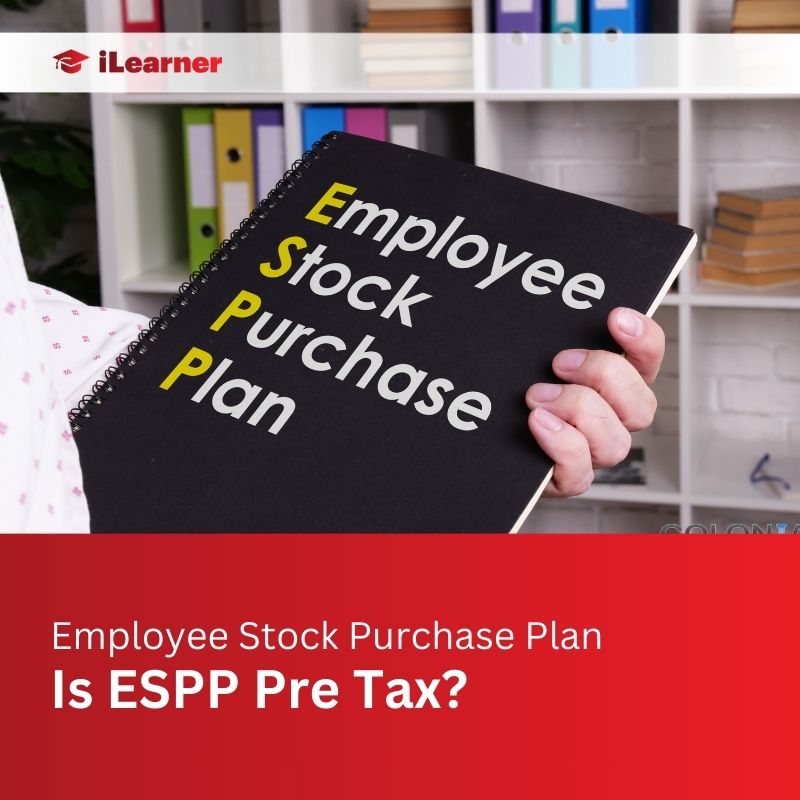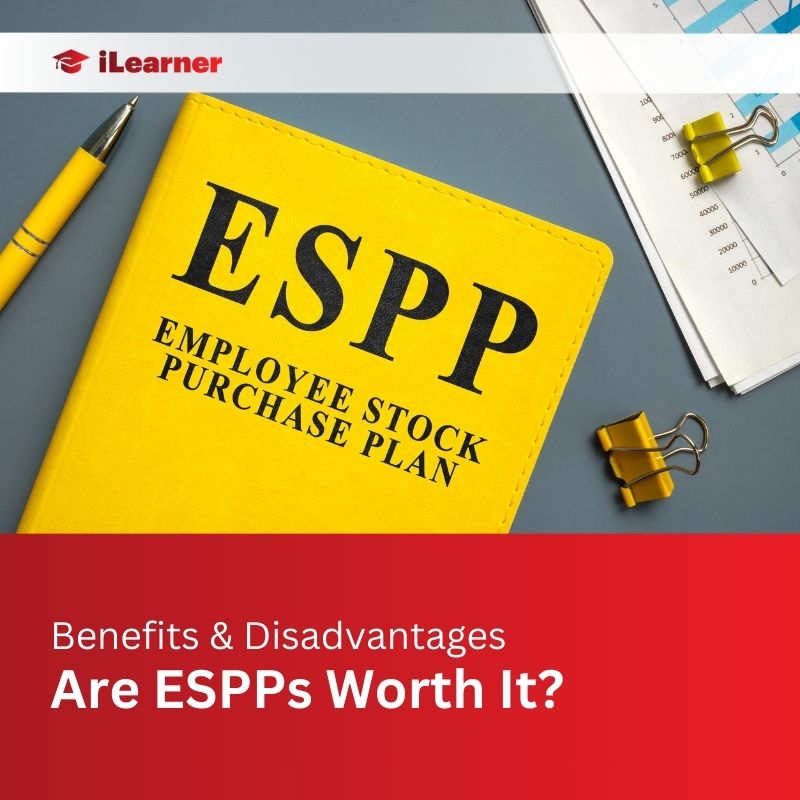ESPP, or Employee Stock Purchase Plan, contributions are characterized by their post-tax deduction nature. This means that the money allocated to an ESPP is taken from an employee’s salary after income tax has already been withheld. Unlike pre-tax contributions to retirement accounts, such as a 401(k) or Traditional IRA, ESPP contributions do not provide an immediate reduction in taxable income.
In the case of pre-tax contributions, the contributed amount is subtracted from the income before calculating taxes, potentially leading to a lower tax liability for the year. However, with ESPP contributions, the tax implications are deferred until the point of selling the acquired stock, where any gains or losses become subject to capital gains tax.
This distinction underscores the importance of understanding the tax treatment of various employee benefit plans and considering the broader financial implications when participating in ESPPs or contributing to retirement accounts.
What is ESPP?
Employee Stock Purchase Plans (ESPPs) are a unique employee benefit offered by publicly traded companies. At its core, an Employee Stock Purchase Plan allows employees to purchase company shares at a discounted price. This discount, typically ranging from 5% to 15%, presents a substantial advantage. Unlike pre-tax contributions to retirement accounts, ESPP contributions are post-tax, directly impacting employees’ take-home pay.
How ESPP Works
Enrollment into ESPP
Participating in an Employee Stock Purchase Plan (ESPP) requires employees to allocate a portion of their salary, usually ranging from 1% to 10%. It’s important to note that these contributions are determined using pre-tax salary figures but are subtracted from post-tax income.
The accumulation phase, typically spanning six months, concludes with the employer using the aggregated funds to buy company stock on behalf of the participating employees. This allows employees to acquire company shares at a discounted rate, fostering a sense of ownership and potential financial benefits tied to the company’s performance.
Lookback Period
Certain Employee Stock Purchase Plans (ESPPs) incorporate a “lookback” provision as a distinctive feature. During the purchase date, employees can acquire company shares at a discounted rate compared to the current market value. If the ESPP includes a lookback feature, employees have the option to purchase shares at the lower of the market prices at the beginning and end of the offering period.
This provision enables employees to buy shares at a discount to the lower of these two prices, potentially maximizing their gains. In essence, the lookback provision enhances the attractiveness of the ESPP by providing participants with an advantageous pricing mechanism based on favorable market conditions within the specified offering period.
Tax Implications of ESPP
ESPP transactions give rise to two distinct types of dispositions, each with specific tax implications for participants. A “Qualifying Disposition” occurs when shares are held for a minimum of two years from the grant date and one year from the purchase date. In this scenario, the discounted purchase price is subject to taxation as ordinary income, while any additional gains receive the advantage of lower capital gains tax rates.
On the other hand, a “Disqualifying Disposition” occurs when shares are not held for the required periods mentioned above. In such cases, the gain, calculated as the difference between the market value at the time of sale and the discounted purchase price, is taxed at a rate of 100% as ordinary income. This distinction in tax treatment emphasizes the importance of understanding and strategically managing the holding periods associated with ESPP shares to optimize the overall tax implications for participating employees.
Strategies to Leverage ESPP for Financial Goals
Supplement Cash Flow
Consider an Employee Stock Purchase Plan (ESPP) as a savings avenue, resembling a high-performance financial tool. Picture it as a tailored program offered by your employer where, at specified intervals, you opt to allocate a portion of your salary towards this structured savings initiative. The notable advantage lies in the program’s discounted acquisition of company shares, akin to a preferential offer on a desired commodity.
To illustrate, suppose you contribute $100, and with the applied discount, the effective cost becomes $85. Even after accounting for associated taxes, this strategic approach translates to an increase in financial resources. In essence, ESPP shares not only facilitate systematic savings but also yield a favorable financial increment.
Fund Short-Term Goals
Leveraging ESPP shares allows employees to accelerate savings towards short-term goals. The discounted shares, when sold, provide additional funds to support various financial objectives.
Transfer ESPP Shares
Imagine you believe strongly in your company’s success or there’s a rule that says you must keep a certain amount of your company’s stock. In that case, instead of just keeping the shares in the Employee Stock Purchase Plan (ESPP), you might want to move them to another account called a brokerage account.
This is like shifting your shares to a different safe space. And the cool part? You get to do this at a lower cost because of the discount you got when buying the shares through the ESPP. So, it’s a smart move for those who have faith in their company’s future or need to meet specific stock-holding rules.
Managing ESPP Holdings
Determine Stock Holding Levels
Evaluating the risk associated with holding company stock is crucial. A general rule of thumb suggests not holding more than 10% of liquid net worth in employer stock.
Automate Selling Strategy
Automating the selling strategy based on predetermined plans is advisable. Setting the ESPP sale strategy to sell immediately after reaching a set threshold ensures adherence to the plan and avoids unintentional breaches.
Conclusion
Participating in an ESPP can be a valuable financial strategy, offering employees an opportunity to accumulate discounted company stock.
While contributions are post-tax, strategic approaches, such as supplementing cash flow, funding short-term and long-term goals, and transferring shares strategically, can maximize the benefits of an ESPP.
Careful planning, adherence to predetermined strategies, and leveraging external insights contribute to integrating ESPP shares seamlessly into a broader financial portfolio.
FAQs: Is ESPP Pre Tax
Q 1: Are ESPP contributions subject to Social Security and Medicare taxes?
Yes, ESPP contributions are generally subject to Social Security and Medicare taxes. While these contributions are made post-tax, they are not exempt from payroll taxes. It’s important for employees to be aware of the overall impact on their take-home pay.
Q 2: What happens to ESPP shares if I leave the company before the purchase date?
If you leave the company before the purchase date in an ESPP, you typically forfeit the opportunity to purchase the shares at a discount. The specifics may vary based on the plan’s rules, and it’s advisable to check the terms of the ESPP to understand the treatment of contributions and potential options in such situations.
Q 3: Can ESPP shares be transferred to another account, and what are the benefits?
Yes, ESPP shares can be transferred to another account, such as a brokerage account. This is beneficial for those who have confidence in their company’s success or need to meet specific stock-holding rules. The transfer is done at a lower cost due to the initial discount received when purchasing the shares through the ESPP.
Q 4: What’s the recommended approach for managing ESPP holdings to minimize risk?
It is advisable not to hold more than 10% of liquid net worth in employer stock to manage risk. Additionally, automating the selling strategy based on predetermined plans, such as selling immediately after reaching a set threshold, helps adhere to a strategic plan and avoid unintentional breaches. Careful evaluation and planning are essential for seamlessly integrating ESPP shares into a broader financial portfolio.
Also Read:




